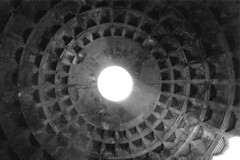As I look at the state of contemporary architecture through the lens of orthodox rather than evangelical thought, I am finding that my ideas of a rigorous modern approach to architecture are beginning to change as well. You have to understand that this has been a bit of a tough pill to swallow; my architectural education was rooted in classic Bauhaus modernism, though in the later years the computer was beginning to introduce a definite post-modern, relativistic bent with all of its blobs and Gehry-isms. Classicism, however, was out of bounds – it just didn’t exist in any meaningful way. It was there to be admired, but never emulated. It was as if architectural precedent began with Corbusier, anything before that was neatly contained in the history classroom and wasn’t to be unleashed in studio. With that background, I began to take a hard look at contemporary church architecture and made a realization…modernism forgot to bring The Wow.
The Wow is admittedly a vague architectural concept, but it’s one I would certainly be fluent in were I involved in designing sacred spaces. Loosely defined, The Wow is the act of unconsciously stopping conversation upon entering a sacred space – often accompanied by a tingling in the spine and goosebumps. While I’m sure there are callous souls out there that will never know the joys of The Wow, I’m sure most people can relate to being in a space that made you just stand silent and realize that life can in fact be transcendent. Interestingly enough, The Wow can also often be experienced at places of supreme natural beauty – Niagara Falls, The Grand Canyon, seeing the Milky Way on a clear night. The bottom line is this: beauty is not always subjective. If you tap into The Truth you unleash The Beauty, because as it was once known: Veritas et Venustas. Truth is Beauty.
Modernism lost The Wow along with its organic link to the past. You can look through architectural history and see the gradual development and evolution of forms, spaces, and ideas – always standing on the shoulders of those who have gone before. But something different happened with Modernism. Faced with a Brave New World and the promise of clear sailing in the machine age, modernism abandoned the ballast of historical precedent and sailed on as if the storms of the barbaric past were left behind. Modernism is utopian; it proposes an untenable ideal that rejects the idea of classic beauty (Truth) precisely because it rejects the idea of classic evil. Then of course post-modernism piled on by proposing many beauties but no truth. Thus the strip mall is beautiful to those who admire the wealth gained by spending as little as possible on as much as possible.
Where does that leave me as I look at contemporary architecture? I am forced to rethink my modernist aesthetics. Notice I didn’t say “reject” my modernist aesthetics, just rethink them. Modernism embraced the Machine Age by abandoning precedent and forging a new path. I need to embrace the Digital Age while restoring precedent and an organic link to human history.
In short: What would Bauhaus be if it brought The Wow?
11 September, 2007
Subscribe to:
Post Comments (Atom)

No comments:
Post a Comment